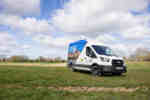The one we originally booked hadn't returned so we found ourselves in a two-year old Ford Transit that had been out on long-term rental and still had a drinking water company's decals on both sides and the bonnet. This van had plastic seats and – horror of horrors – no air conditioning.
We covered 1,200 kilometres easily enough but the heat was unbearable. At one of our service station stops, ironically made to stock up on drinking water, it was 38.1 degrees centigrade. This set me wondering about the presence of air con on UK vans.
According to our New Vehicle Data Department, there are currently 1,767 different new light commercial vehicles available in the UK, of which 1,075 have air conditioning, although mostly as an option only.
This equates to around 60% of all LCV's on the market today. During my turns as passenger, I phoned around light commercial manufacturers and importers to find out what the take-up of air-con as an option actually was and discovered the numbers were very surprising. On average, less than 10% of all new LCVs have air-con and in some model ranges it is under 1%. The highest, I discovered, was 16%.
So why is there such little apparent interest in air-con on a van? Researching operators, I found the reasons varied – ranging from the extra cost of fitting and the diversion of much-needed engine power, especially when fully laden, to increased fuel use and even the risk of expensive damage due to dashboard drink spillages. Hence, large operators and rental companies tend not to bother with the feature.
However, it is a different story when it comes to the owner-driver. These people are more often prepared to pay for air conditioning and it is this customer who is responsible for the bulk of air-con vans on the roads.
Perhaps surprisingly, there is little demand for air conditioning on the used market either, despite the fact that this is dominated by the owner-driver. The reasons for this are the same as in the new market.
Fleets see this equipment as an additional risk and, in the used market, where cost and risk is paramount, there is a similar perception. According to David Hill, research for Red Book has revealed that, under the right circumstances, air con can add £200-£300 to the value of a two-year-old car-derived model such as Astravan.
When it comes to larger panel vans, however, the need for a bulkhead to prevent wasting power cooling the load space is more off-putting so they are likely to remain relatively rare.
Red Book has recently seen highly-specified Transit Connects, with air con, achieving a premium in closed sale. But in terms of the overall market there are simply insufficient numbers yet to discern an overall pattern for the added value. Commercial Vehicle Monitor, however, forecasts a similar premium for air-con in 12-month forecasts, dropping to around £100 at three years, 60,000 miles, depending on model.
Perhaps the extreme temperatures we are now experiencing around Europe may have an eventual impact on the perceived value of air conditioning. For my part, it was a relief to get out of the sweltering Transit and travel home in the cool cabin of a plane.'
Air-con take-up on new vans
Mercedes-Benz Vito: 16%
Vauxhall: 11.9%
VW Transporter: 10%
All Ford vans: 6%
VW Caddy: 6%
VW LT: 3%
Mercedes-Benz Sprinter: 3%
Fiat 0-5%
















Login to comment
Comments
No comments have been made yet.